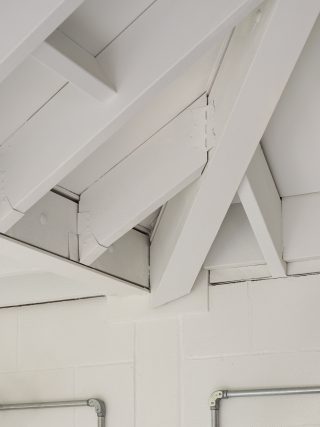James Alder Architects has added a russet extension to a home in north-west London, which has a steeply pitched roof following the outline of a now demolished lean-to.
Architect James Alder was asked to design the extension for a couple who, having lived in the flat for some time, wanted a bigger kitchen and dining space with better access to their garden.
The resulting 26-square-metre, single-storey extension built on a budget of £70,000 expands to the side and rear of the ground floor flat, which is set within a semi-deteched Victorian house in Willesden Green, and is fitted with sliding glass doors that directly connect to a patio. The project, called Manber Jeffries House, also saw the reorganisation of the existing ground floor plan.


The extension replaces a small lean-to kitchen and in a nod to its predecessor, the vaulted roof at the structure is pitched at the same angle. The slope of the roof also mediates the level difference between the lower ground floor kitchen and dining room, and the rest of the living space located on the ground floor.
“The project was really an exercise in creating the most amount of volume and architectural expression possible, using the cheapest off-the-shelf components, that are all very carefully set-out and left fully exposed to try and achieve this. The exception was a complicated steel frame that held all of this together,” Alder told Architecture Today.
“The exposed steelwork supports a complex roof geometry, and cantilevers in two directions to form an elaborate tectonic to the forming of openings to the garden beyond. A focus on detail, and a deliberate honesty and celebration of stark, layered construction is employed throughout.”
Internally, the space is finished in minimalist patchwork of materials with a mixture of exposed and white-painted blockwork, wooden floors and window frames, and a flash of muted blue that has been introduced for cabinetry and niches. The red brickwork of the former rear wall of the house has also been left uncovered.
“Key to the project was the retention and extension of a substantial brick party wall that had historically supported a symmetrical pair of pitched garden outbuildings and lavatories,” explained Alder.
“These were already semi-demolished, and had been heavily neglected in recent decades. Victorian glasshouses and ancillary garden buildings, built as appendages to the boundary walls of formal gardens, formed a particularly strong inspiration for both the formal language and the materiality of the project.”



































